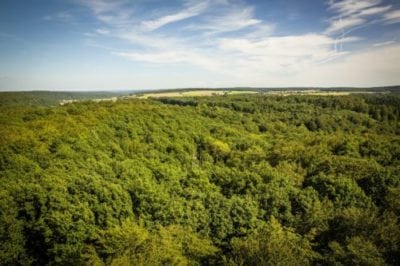
There’s a caveat to this, which I’ll get to in a minute. First, let’s dispel a common myth. Many people believe that using lumber from hardwood trees is bad for the environment. They associate trees with environmentalism, and so cutting down trees must be bad.
In fact, it’s a little more complicated than that. Yes, it’s true that some species of hardwood trees can take up to half a century or more to mature. And yes, trees do naturally absorb carbon dioxide from the atmosphere. However, when undertaken responsibly, cutting down trees, even old trees, does not necessarily have a negative impact on the environment. On the contrary, it is often beneficial to the overall health of the forest.
Wood, unlike metals and petroleum products, is a renewable resource. New trees can be planted as old ones are harvested and, with a little care, this process can continue indefinitely. The United States Department of Agriculture (USDA) Forestry Service agrees. Their website clearly outlines best practices for the responsible harvesting of timber, practices which promote the health of public and private forests. And the Environmental Protection Agency and USDA have both included responsibly-sourced hardwoods on their lists of “bio-preferred” materials recommended for federal building projects. These agencies consider wood carbon neutral because it continues to contain absorbed carbon dioxide even after the tree is cut down. Plus it’s biodegradable.
But now time for the caveat. Timber must be harvested responsibly. Clearcutting an entire old growth forest to grow crops or selectively harvesting endangered species of mahogany are obviously not responsible harvesting practices. In order to protect local ecosystems, logging must be undertaken with an eye to the overall health of the forest. Foresters have thus devised a number of systems for harvesting timber, each of which has appropriate applications under certain conditions. Properly applied, these systems can help maintain or improve the health of a given forest while at the same time satisfying commercial demand for wood. Here is a brief overview of those systems.
- Clearcutting – The practice of removing all trees in a given area. Clearcutting is the most controversial system as it levels huge swaths of forest and is often associated with forest destruction rather than regeneration. However, clearcutting can be a useful method to restore the health of certain kinds of forest. This is often true of forests containing species that don’t do well in shade. This system can also be essential when whole stands of trees are ravaged by disease.
- Seed-tree method – The practice of removing all but a few healthy, seedbearing trees intended to repopulate the forest. This system is similar to clearcutting, but helps preserve the genetic lines of a given forest’s trees.
- Shelterwood – The practice of selectively harvesting certain trees while maintaining a shelter of overgrowth. This system helps protect the appearance of a forest while providing opportunities for new growth in the shelter of older trees. This system works well for species that tend to thrive in shade.
- Group selection – The practice of removing clumps of mature trees at regular intervals. This system helps to improve access to sunlight and essential nutrients for existing trees while doing little to upset wildlife that have adapted to forest conditions.
- Single tree selection – The practice of removing individually selected trees while leaving the majority of trees standing. Ostensibly, this is the least intrusive system. When only trees of a certain desirable species are selected, however, this system can upset an ecosystem’s balance. This system is very beneficial to forests when weak or unhealthy trees are selected.
No matter what system is used, the key to responsible timber harvesting is maintaining the integrity of the forest. Qualified foresters are an essential part of the process. Additionally, there are a number of agencies that serve to monitor timber harvesting and lay out best practice guidelines. Organizations like the Forest Stewardship Council and the Sustainable Forestry Initiative provide useful resources for private and public landowners.
Efforts in the U.S. to balance environmental and economic concerns seem to be paying off. According to the most recent National Report on Forest Resources, the overall volume of trees in this country has increased since 1950, while the rate of growth is higher than the rate of harvest. And that’s what sustainability is all about.
So, when planning your green renovation, don’t take hardwoods off the table. Wood is a sustainable, eco-friendly, carbon neutral option, which when harvested responsibly, can promote the health of our forests. Using hardwood materials is a choice you can feel good about. And aesthetically, of course, you can’t do any better.
For more information, consult the websites of the Forest Stewardship Council, the Sustainable Forestry Initiative and the National Wood Flooring Association.
References: https://archive.epa.gov/greenbuilding/web/pdf/sustainable-design-permitting-toolkit-06_27_13_formatted.pdf.
https://ic.fsc.org/en/what-is-fsc/what-we-do.
https://sftool.gov/material/1964/wood-flooring.
https://www.epa.gov/sustainability/learn-about-sustainability#what.
http://extension.oregonstate.edu/douglas/sites/default/files/documents/forestry/ThinFact04.pdf.
https://idahoforests.org/wp-content/uploads/2016/12/WhyAreSomeForestsClearcut-1.pdf.
http://msue.anr.msu.edu/news/timber_harvest_methods.
https://www.nrs.fs.fed.us/fmg/nfmg/docs/mn/harvesting.pdf.
https://www.thisoldhouse.com/ideas/earth-friendly-flooring.
https://www.thoughtco.com/us-forest-facts-on-forestland-1343034.
https://www.wbdg.org/resources/green-building-standards-and-certification-systems.



